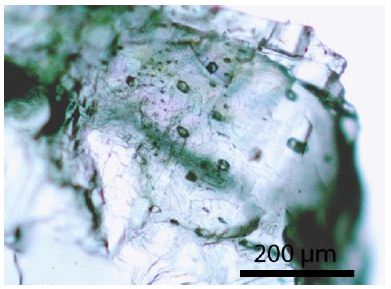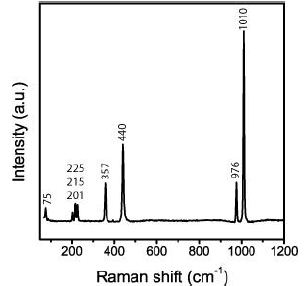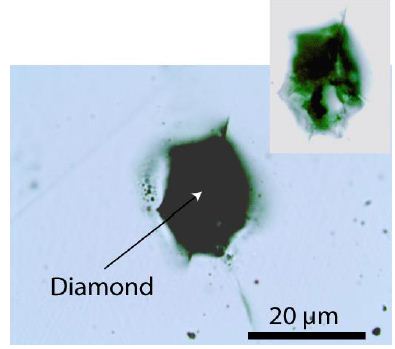Abstract
In zircon from the kimberlite pipe Koffiefontein Mine, Free State Province, South Africa, we describe in short two types of diamond: Besides this single-band diamond, there are also two-phase diamond particles present with a Raman doublet at 1324.5 and 1330.6 cm-1. The applicability of the Ti-in zircon thermometer in the described case is doubtful.
Keywords
Zircon, Diamond, Lonsdaleite, Carbonaceous material, Raman spectroscopy
Introduction
In the Koffiefontein Kimberlite farm near the town of Kimberley in 1870, diamonds were found for the first time. The diamonds are of good quality because they are of excellent clarity. Famous are the pink ones. The mines have had a varied history. Details are in Naidoo et al. [1]. Zircons from Kimberlites are studied, for example, by Page et al. [2]. In the last contribution, they determined for zircons using the Ti in zircon thermometry for the Kaapvaal Craton zircons a mean of 750 ± 57°C, which implies shallow depths of formation of zircon outside the diamond field of stability. The resulting pressure is about 30 kbar.
In this contribution, we will show that there are some uncertainties in the formation conditions. It raises the question of why the studied zircon is full of diamonds. As we can see, these diamonds are not only “classic” diamonds with a very sharp Raman band at 1333 cm-1 [3]. In the sample, we obviously have a significant portion of hexagonal diamonds in addition to cubic diamonds.
Sample and Methods
Sample
As a sample, we used a small museum piece about 300 µm thick and 560 x 700 µm large zircon chip on both sides polished. After polishing, follow a careful cleaning in an ultrasound water bath. The very transparent zircon is almost colorless and contains slight fluid inclusions and some, often corroded, diamond crystals together with a small amount of carbonaceous material. Figure 1 gives an impression of the sample. Graphite could not proofed.

Figure 1: The polished zircon chip used was from the Koffiefontein Mine/South Africa
Figure 2 shows a typical Raman spectrum of the matrix zircon, and Table 1 shows the measured Raman lines, the Raman active modes, and the intensity, according to Stangarone et al. [4].

Figure 2: Typical Raman spectrum of zircon from the Koffiefontein Mine/South Africa
According to Nicola and Rutt [5], the Raman data of the used zircon demonstrate nearly poor zircon with only traces of hafnon and no remands of reidite. In tiny areas, increase the HfSiO4 portion to higher values notified by a shift of the B1g prominent bands from 1010 to 1015 cm-1.
Table 1: Raman lines of the studied zircon sample and the corresponding Raman modes
|
Raman line (cm-1) |
Raman mode | Intensity (%) |
| 75 | – | |
|
201 |
A1g | 6.2 |
| 215 | B1g |
11.5 |
|
225 |
Eg | 10.5 |
| 357 | Eg |
20.5 |
|
440 |
A1g | 40.9 |
| 976 | A1g |
20.8 |
|
1010 |
B1g |
100.0 |
Methods
Besides the classic polarization microscopy, we used a petrographic polarization microscope with a rotating stage, coupled with the RamMics R532 Raman spectrometer working in the range of 0-4000 cm-1 using a 60 mW single mode 532 nm laser. For the exposure, 30 mW on the sample is the standard condition for the study. More details are in Thomas (2023a) [6].
Key Observations
Generally, the zircon is a classic zircon without any remnants of reidite. There are three possibilities: (i) the zircon was formed at low temperatures and pressures (750°C, 30 Kbar), as Page et al. [2] wrote, zircon/reidite formed at significantly higher temperatures (~1000°C) and pressures (higher than 8 GPa) and stay at such, however a little bit lower values for a long time that the structure transformation to zircon is retrograde [7], or there is an additional zircon type, which not incorporated titanium because it was not present in the primary magmatic melt. Thomas (2023b) [8] demonstrates that the water-clear zircon from the Udachnaya diamond pipe, Siberia, contains tiny diamond crystals in the growth zones of this zircon. That means that during the zircon growth, the diamonds were trapped in the diamond stability field and not, according to Page et al. [2], at low temperatures of 727 ± 63°C [8]. In the zircon, there are some tiny diamond crystals (gray points in Figure 1) together with some carbonaceous material. Figure 3 shows such a typical diamond crystal. From 15 and 6 different diamond crystals, about 10 to 20 µm in diameter, result for the first-order band the data presented in Table 2.

Figure 3: A typical diamond crystal in zircon from the Koffiefontein Mine/South Africa. The diamond contains carbonaceous material (black parts in the upper right photomicrograph). Carbon is not graphite, as indicated by the typical and broad D1, G, and D2 bands (Beyssac et al. (2002).
A reference diamond (water-clear crystal from Brasilia) gave (1332.3 ± 0.5 cm-1) – see Thomas et al. [7]. A couple of diamond grains in zircon (Table 2) represent two-phase particles of diamond-lonsdaleite [9,10]. Lonsdaleite is a stable hexagonal polytype of diamond. Another explanation for the “two-phase” crystals is the higher and variable isotope portion of 13C [11] in diamonds. However, all diamonds in the sample have low first-order diamond band values (Table 2). That speaks for the hexagonal diamond polytype (Figure 4) [12].

Figure 4: Raman spectrum of a typical two-phase diamond-lonsdaleite crystal. The blue and red show the mathematical deconvolution of the bulk spectrum into Gaussian components.
Besides the two different diamonds (diamond and lonsdaleite-bearing diamond), there are also a tiny couple of fluid inclusions in zircon. The study is complicated because these inclusions are deep under the surface of zircon. Only one strong Raman band (3429.3 ± 2.0 cm-1, n = 9) would determined. According to Hurai et al. [13,14] this band can be provisionally assigned as antarcticite [CaCl2 · 6H2O].
Table 2: Results of the Raman measurements of the first-order diamond bands of different tiny crystals distributed in the zircon from the Koffiefontein Mine/South Africa.
|
First-order Raman band(s) |
Raman shift (cm-1) | FWHM (cm-1) | n | Raman shift (cm-1) | FWHM (cm-1) | n |
|
Single band |
1326.8 ± 2.7 | 23.1 ± 9.0 | 15 | |||
| Doublet |
1324.5 ± 1.7 |
15.8 ± 6.0 | 6 | 1330.6 ± 0.5 | 5.3 ± 1.1 |
6 |
n: number of measured crystals
FWHM: Full Width at Half Maximum
Discussion
This short paper describes diamond-bearing zircon from the Koffiefontein Mine, Free State Province, South Africa. The zircon contains many diamonds with a relatively low first-order diamond band at 1326.8 cm-1. Besides this single-band diamond, there are also two-phase diamond particles present with a Raman doublet at 1324.5 and 1330.6 cm-1. The diamond doublet is, according to the authors, a combination of cubic and hexagonal diamonds. The hexagonal lonsdaleite forms in nature in meteorite debris when meteors containing graphite strike the Earth. The immense heat and stress of the impact transform the graphite into diamond but retain the graphite hexagonal crystal lattice. In earth material, lonsdaleite was described by Shumilova et al. [10] from the Kumdykol diamond deposit in North Kazakhstan. Thomas et al. [9] found lonsdaleite in a synthetic diamond sample (Figure 5 in [9]), and now we describe lonsdaleite from the Koffiefontein Mine, Free State Province, South Africa.
Acknowledgment
I dedicate this short paper to Dmytro K. Voznyak, who died on September 14, 2023, before finishing this paper. He passed away at the age of 85.
References
- Naidoo P, Stiefenhofer J, Field M, Dobbe R (2004) Recent advances in the geology of the Koffiefontain Mine, Free State Province, South Africa. Lithos 76: 161-182.
- Page F.Z, Fu B, Kita NT, Fournelle J, Spicuzza MJ, et al. (2007) Zircons from kimberlite: New insights from oxygen isotopes, trace elements, and Ti in zircon thermometry. Geochimica Cosmochimica Acta 71: 3887-3903.
- Zaitsev AM (2010) Optical Properties of diamond. A Data Handbook. Springer Pg: 502.
- Stangarone C, Angel RJ, Prencipe Mihailova B, Alvaro M (2019) New insights into the zircon-reidite phase transition. American mineralogist 104: 830-837, Supplementary material.
- Nicola JH, Rutt HN (1974) A comparative study of zircon (ZrSiO4) and hafnon (HfSiO4) Raman spectra. Journal of Physics C: Solid State Physics 7: 1381- 1386.
- Thomas R (2023a) Growth of SiC whiskers in beryl by a natural supercritical VLS process. Aspects in Mining & Mineral Sciences 11: 1292-1297.
- Thomas R, Davidson P, Rericha A (2022) Prismatine granulite from Waldheim/Saxony: Zircon-Reidite. Journal of Earth Environment Science 103: 1-3.
- Thomas R (2023b) The Königshainer Granite: Diamond inclusions in zircon. Geol Earth Mar Sci 5: 1-4.
- Thomas R, Rericha A, Davidson P, Beurlen H (2021) An unusual paragenesis of diamond, graphite, and calcite: A Raman spectroscopic study. Estudos Geologicos 31: 3-15.
- Beyssac O, Coffeé B, Chopin C, Rouzaud JN (2002) Raman spectra of carbonaceous material in metasediments: a new geothermometer. J metamorphic Geol 20: 859-871.
- Shumilova TG, Mayer E, Isaenko SI (2011) Natural monocrystalline Lonsdaleite. Doklady Earth Sciences 441: 1552-1554.
- Anthony TR, Banholzer WF (1992) Properties of diamond with varying isotopic composistion. Diamond and Related Materials 1: 717-726.
- Bhargava S, Bist HD, Sahli S, Aslam M, Tripaathi HB (1995) Appl Phys Lett 67: 1706-1708.
- Hurai V, Huraiová M, Slobodník M, Thomas R (2015) Geofluids – Developments in Microthermometry, spectroscopy, Thermodynamics, and Stable Isotopes. Elsevier.